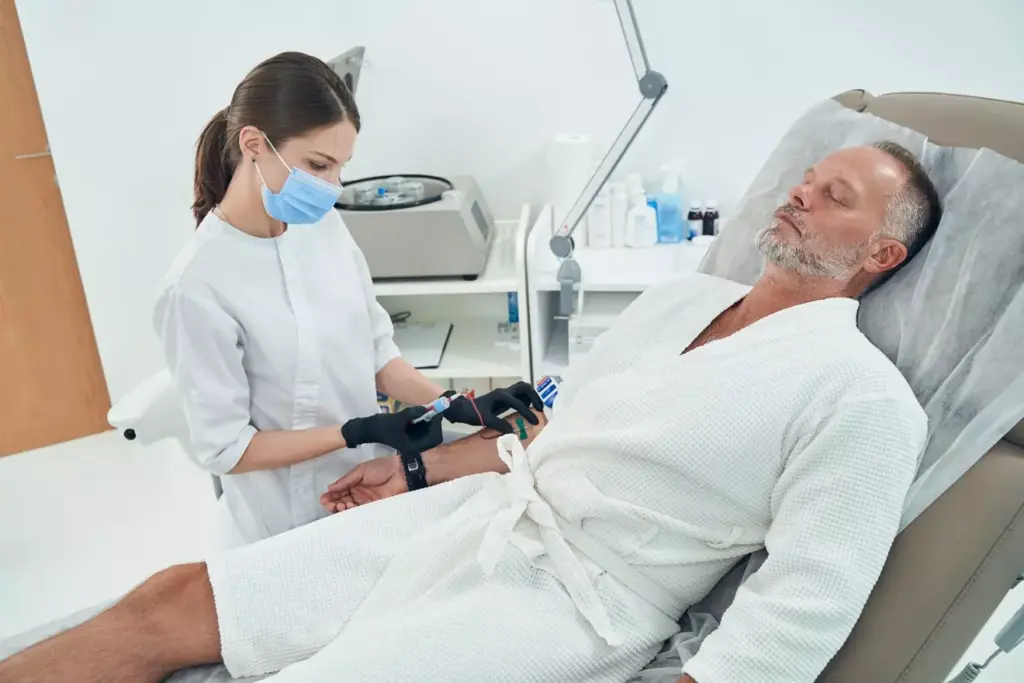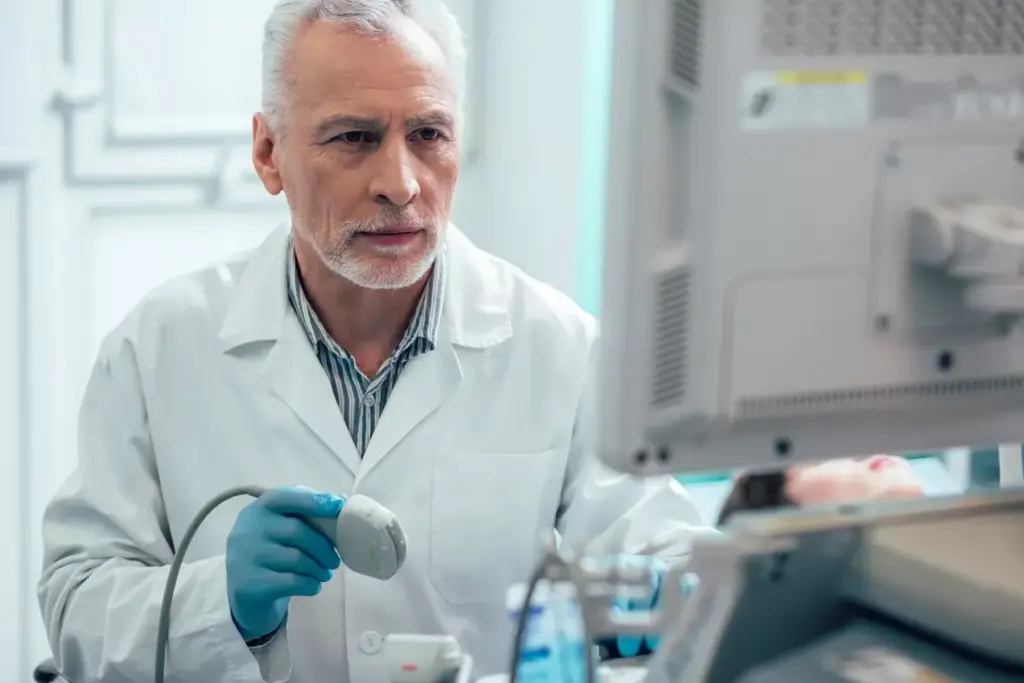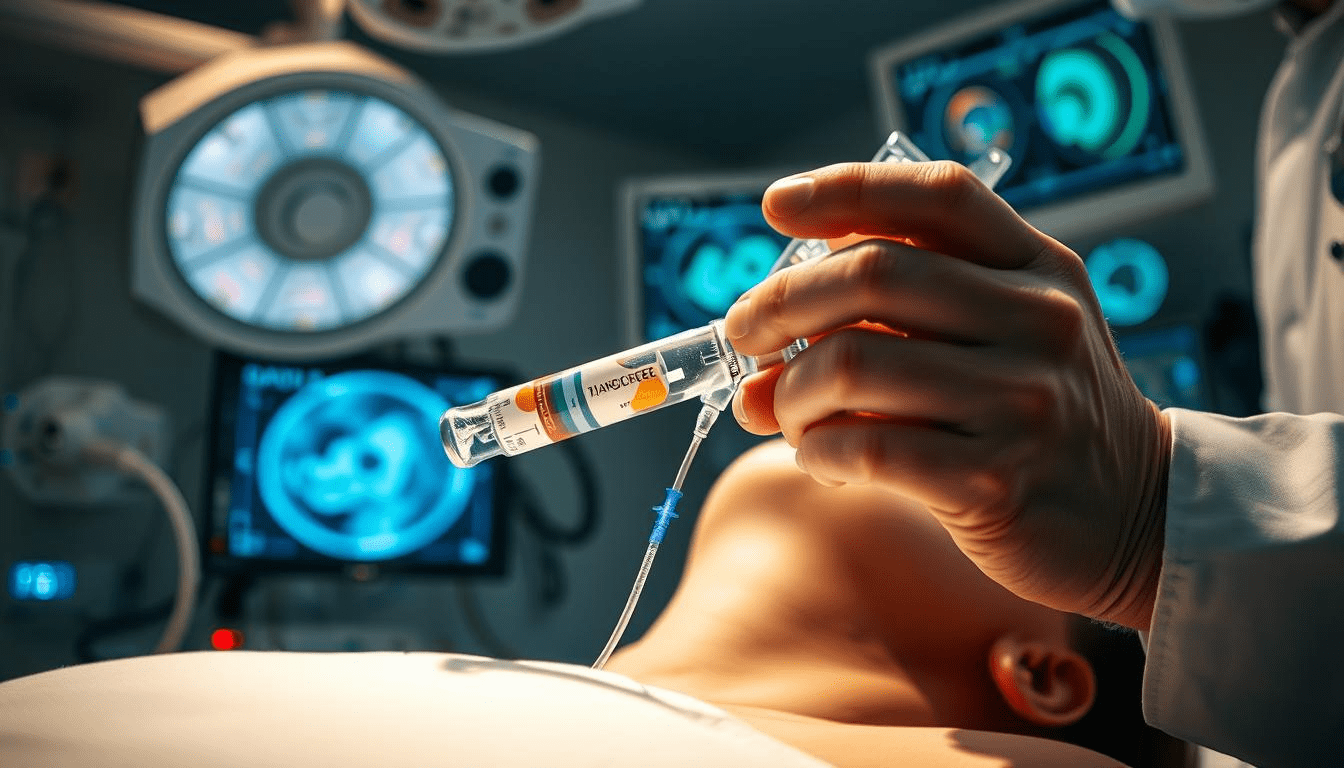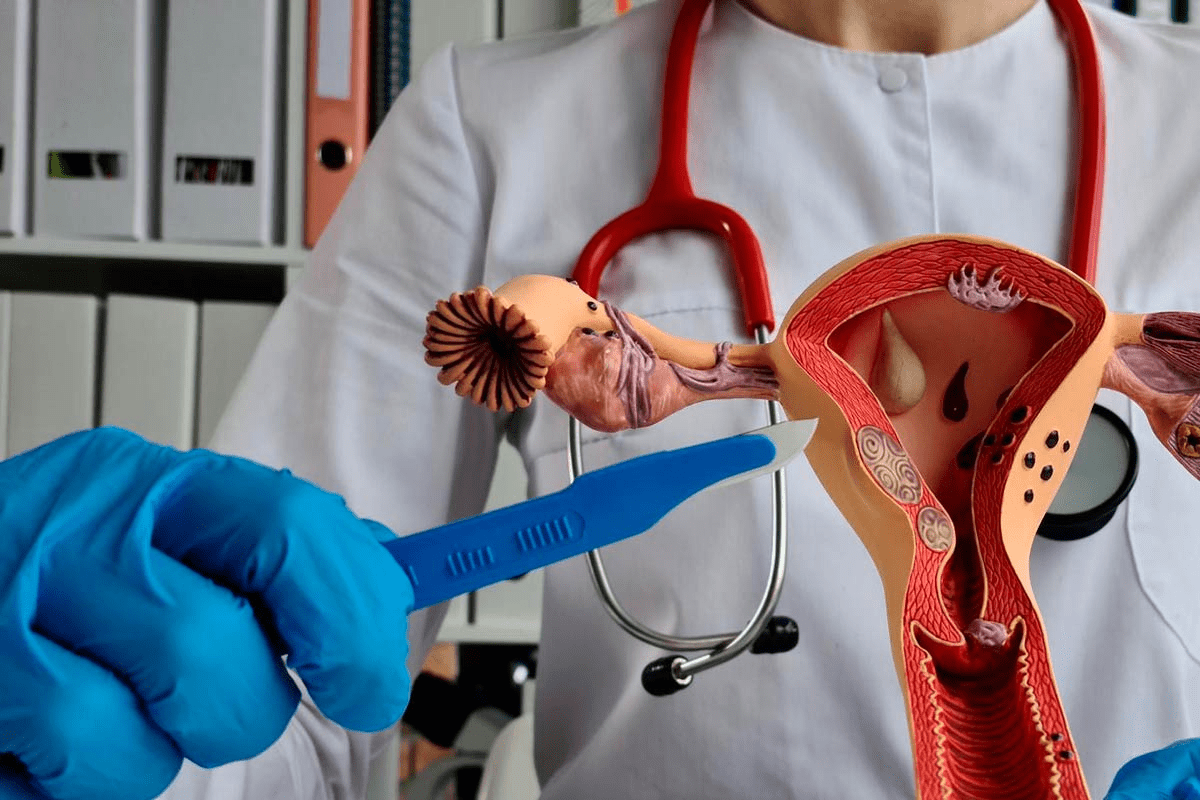Last Updated on November 26, 2025 by Bilal Hasdemir

CAR-T cell therapy is a new way to treat some blood cancers. But, it comes with big side effects. At Liv Hospital, we aim to give top-notch care to patients from around the world. Our Oncology Evaluation Center now helps those getting CAR T-cell therapy, making sure they get all the care they need.
It’s key to know the complications of CAR-T cell therapy before starting. We want to help you understand what might happen after getting CAR-T cells. This way, you can feel more confident as you go through your treatment.
Key Takeaways
- CAR-T cell therapy is a revolutionary treatment for certain blood cancers.
- Understanding possible side effects is key for making good choices.
- Liv Hospital offers full support for patients from other countries.
- The Oncology Evaluation Center now helps more with CAR T-cell therapy.
- Knowing what might happen can help you through your treatment.
Understanding CAR T-Cell Therapy: A Revolutionary Cancer Treatment
We are seeing a big change in cancer treatment with CAR T-cell therapy. It’s a new method that has shown great promise in fighting some blood cancers.
What Is White Blood Cell Therapy (CAR-T)
CAR T-cell therapy, also known as white blood cell therapy or immunotherapy CAR T, is a new kind of treatment. It takes T cells from a patient’s blood, changes them to find cancer cells, and then puts them back in the body.
This treatment is meant to make the immune system better at fighting cancer.
How CAR-T Cell Therapy Works Against Blood Cancers
CAR-T cell therapy targets specific cancer cells and uses the body’s immune system to kill them. The steps are:
- Extracting T cells from the patient’s blood
- Genetically modifying these T cells to produce a chimeric antigen receptor (CAR) that recognizes a specific protein on cancer cells
- Expanding the modified T cells in a laboratory
- Infusing the CAR T cells back into the patient
This method allows for a more precise attack on cancer cells. It could lead to better results for patients with certain blood cancers.
The CAR-T Cell Infusion Process
The CAR T cell infusion process is key. After the CAR T cells are ready, they are given back to the patient through an IV. This is usually done in a hospital setting to watch for any immediate side effects.
Our center offers full support during the CAR T-cell therapy process. We make sure patients get the care they need before, during, and after the infusion.
The 7 Most Common CAR T Side Effects: An Overview
It’s important for patients to know about CAR T-cell therapy side effects. This treatment uses a patient’s T cells, modified to fight cancer. While it’s a breakthrough in cancer treatment, it comes with several side effects.
Why Side Effects Occur After CAR-T Therapy
Side effects happen because of the body’s reaction to the CAR T cells. When these cells are put back into the patient, they cause a big immune response. This is known as a “cytokine storm” or Cytokine Release Syndrome (CRS).
CRS is a serious side effect that can be life-threatening. It happens when the CAR T cells release cytokines, causing inflammation. We watch patients closely for signs of CRS and other side effects.
CRS is a big concern, affecting up to 70–90% of patients. This shows how important it is to monitor and prepare for these side effects.
The Timing of Side Effects After Treatment
Side effects can happen at different times after CAR T-cell therapy. CRS usually starts within a few days to a week after the infusion. Other side effects, like neurological problems, can happen at the same time or a bit later.
Patients need to stay in touch with their healthcare team during this time. Regular check-ins and an open line to the Oncology Evaluation Center are key. This helps us quickly handle any side effects.
Risk Factors for Developing Severe Complications
Some factors can make severe complications more likely. These include the patient’s health, the type of CAR T cells, and the dose. Conditions like heart disease or neurological disorders can also raise the risk.
We support patients through their treatment, focusing on both the cancer and side effects. By understanding risks and monitoring closely, we can lessen side effects and better outcomes.
Cytokine Release Syndrome (CRS): The Primary Challenge
CRS happens when CAR T-cells are activated and release cytokines. This leads to a strong immune response.
Recognizing CRS Symptoms: Fever, Fatigue, and Flu-like Illness
CRS symptoms can vary from mild to severe. They include high fever, fatigue, and flu-like symptoms. In serious cases, CRS can cause life-threatening issues like hypotension and organ failure.
Common Symptoms of CRS:
- Fever
- Fatigue
- Nausea and vomiting
- Headache
- Muscle pain
Severity Grades of Cytokine Storm
CRS is graded from 1 to 4, with Grade 1 being the least severe and Grade 4 the most severe. Knowing the severity grade helps decide the right treatment.
| Grade | Symptoms | Treatment |
|---|---|---|
| 1 | Mild symptoms | Supportive care |
| 2 | Moderate symptoms | Tocilizumab or steroids |
| 3 | Severe symptoms | Tocilizumab and steroids |
| 4 | Life-threatening symptoms | Intensive care and aggressive treatment |
Treatment Options Including Tocilizumab and Steroids
Treatment for CRS varies based on severity. Mild cases might just need supportive care. For more severe cases, Tocilizumab and steroids are often used. Tocilizumab helps reduce CRS severity by blocking IL-6 receptors.
We watch patients closely for CRS signs during CAR T-cell therapy. We’re ready to act fast to manage this serious condition.
Neurological Toxicities: ICANS and Brain Complications
Neurological toxicities, including ICANS, are serious side effects after CAR T-cell infusion. They can cause mild confusion to severe encephalopathy. This affects the patient’s quality of life and needs quick medical help.
Symptoms from Mild Confusion to Severe Encephalopathy
Neurological toxicity symptoms vary among patients. Some may feel mild confusion or disorientation. Others might have severe symptoms like seizures or encephalopathy. Early recognition of these symptoms is key for effective management.
Patients getting CAR T-cell therapy can show different neurological symptoms. These include:
- Confusion and disorientation
- Memory problems
- Seizures
- Encephalopathy
Diagnostic Approaches for Neurotoxicity
Diagnosing neurological toxicity involves a detailed assessment. This includes clinical evaluation, lab tests, and imaging studies. Our team uses a multidisciplinary approach to find the cause and severity of neurotoxicity in each patient.
The diagnostic process may include:
| Diagnostic Tool | Purpose |
|---|---|
| Clinical Evaluation | Assess neurological symptoms and overall health |
| Laboratory Tests | Check for abnormalities in blood work |
| Imaging Studies (MRI, CT) | Examine the brain for structural abnormalities |
Current Management Strategies for Brain-Related Side Effects
Managing neurological toxicities needs a personalized approach. This often includes a mix of medications and supportive care. Tocilizumab and steroids are commonly used for severe ICANS and other neurological complications.
We work closely with patients and their families to create a personalized care plan. Our center’s staff can directly admit patients to the hospital if needed. This streamlines the care process.
Cytopenias: Blood Count Abnormalities After Immunotherapy CAR T
Cytopenias are a common side effect of CAR T-cell therapy. They can affect different blood cells, like neutrophils, red blood cells, and platelets. This can lead to infections, anemia, and bleeding disorders.
Neutropenia and Infection Risk
Neutropenia is when the number of neutrophils, a key white blood cell, drops. This makes it harder for the body to fight off infections. Patients with neutropenia may need close monitoring and sometimes antibiotics to prevent infections.
“The risk of infection is a big worry for patients getting CAR T-cell therapy, says a leading expert in hematology. “We watch them closely and act fast to keep infections away.”
Anemia and Its Impact on Recovery
Anemia is when there are not enough red blood cells or hemoglobin. It can cause fatigue, weakness, and shortness of breath. It’s important to treat anemia quickly to help patients recover well from their treatment.
Thrombocytopenia and Bleeding Concerns
Thrombocytopenia is when there are not enough platelets, which can lead to bleeding. Patients might see bruising, petechiae, or severe bleeding. To manage this, we watch platelet counts and give transfusions when needed.
Many patients need blood or platelet transfusions almost every day because of treatment side effects. Our team is here to help, explaining the different cytopenias and how they affect recovery.
Infection Susceptibility Following CAR-T Transplant
CAR-T cell therapy is a breakthrough in cancer treatment but makes patients more prone to infections. It’s vital to know the risks and use effective ways to prevent them.
Bacterial, Viral, and Fungal Infection Risks
Patients after CAR-T cell therapy face a higher risk of infections because their immune systems are weak. This weakness can lead to serious bacterial, viral, and fungal infections.
Bacterial infections are a big worry, with Gram-negative bacteria being a particular concern. Viral infections, like CMV and EBV, can also happen. Fungal infections are less common but can be very serious and need quick treatment.
Preventive Strategies and Antimicrobial Prophylaxis
We use many ways to prevent infections in CAR-T cell therapy patients. Antimicrobial prophylaxis is a key method. It includes antibiotics, antivirals, and antifungals based on the patient’s risk.
For example, some patients get antibiotics to stop bacterial infections. Others might get antiviral meds to prevent viral infections. The treatment plan is made just for each patient.
“The use of antimicrobial prophylaxis has become a cornerstone in the management of patients after CAR-T cell therapy, significantly reducing the risk of life-threatening infections.”
Vaccination Considerations After CAR-T Therapy
Vaccines are also important in preventing infections after CAR-T cell therapy. But, the timing and type of vaccines need careful thought because of the patient’s weakened immune system.
Live vaccines are usually avoided right after CAR-T therapy because of the risk of complications. Instead, inactivated or mRNA vaccines might be suggested. The right vaccination plan should be decided with the healthcare team.
By knowing the risks and using these preventive steps, we can greatly lower the chance of infections. This helps patients recover better after CAR-T cell therapy.
Cardiovascular Complications After CAR-T Cell Infusion
While CAR T-cell therapy is a groundbreaking treatment, its impact on the cardiovascular system cannot be overlooked. As we continue to explore the side effects of this innovative cancer treatment, it’s essential to understand the cardiovascular complications that can arise.
Hypotension and Cardiac Dysfunction
Hypotension, or low blood pressure, is a common issue following CAR-T cell infusion. This condition can lead to inadequate blood flow to vital organs, potentially causing cardiac dysfunction. Cardiac dysfunction refers to the heart’s inability to pump blood effectively, which can be a serious complication.
Arrhythmias and Other Heart-Related Events
Arrhythmias, or irregular heartbeats, are another cardiovascular complication associated with CAR T-cell therapy. These can range from mild to severe and may require immediate medical attention. Other heart-related events, including myocardial infarction, can also occur.
Monitoring and Interventions for Heart Issues
Monitoring patients for cardiovascular complications after CAR-T cell infusion is critical. This includes regular checks for signs of hypotension, cardiac dysfunction, and arrhythmias. Interventions may involve medication to manage blood pressure or heart rhythm.
| Cardiovascular Complication | Description | Potential Intervention |
|---|---|---|
| Hypotension | Low blood pressure potentially leading to inadequate organ perfusion | Fluid resuscitation, vasopressors |
| Cardiac Dysfunction | Inability of the heart to pump blood effectively | Inotropic support, heart failure management |
| Arrhythmias | Irregular heartbeats | Anti-arrhythmic medications, cardioversion |
By understanding the cardiovascular complications of CAR T-cell therapy, healthcare providers can better manage patient care. Our team is committed to providing complete support to patients undergoing this treatment.
Dermatological and Allergic Reactions to CART Treatment
When it comes to CAR T-cell therapy, skin reactions are a big deal. This treatment is a game-changer for some cancers but can cause skin issues.
Common Skin Manifestations and Rashes
Reactions to CAR T-cell therapy can show up as rashes, itching, and dry skin. These can be mild or serious and might come with other symptoms like fever or tiredness.
Common skin manifestations include:
- Rashes, which can appear anywhere on the body
- Itching or pruritus, which can be uncomfortable and persistent
- Dry skin or xerosis, leading to irritation and possible cracking
Differentiating Between Allergic and Treatment-Related Reactions
It’s important to tell the difference between allergic reactions and side effects from treatment. Allergic reactions happen when the body reacts to something it shouldn’t. Treatment-related reactions come from the CAR T-cell therapy itself.
Key differences include:
- The timing of the reaction, with allergic reactions often occurring shortly after exposure
- The presence of other symptoms such as hives or swelling in allergic reactions
- The distribution of the rash, with treatment-related rashes often being more widespread
Management of Skin Toxicities
It’s key to manage skin side effects well for patient comfort and treatment success. This includes using topical treatments, adjusting the CAR T-cell therapy, and supportive care.
Management approaches include:
- Topical corticosteroids to reduce inflammation
- Antihistamines or other medications to alleviate itching and discomfort
- Moisturizers to combat dry skin and prevent cracking
Recent studies show that skin problems can happen months after CAR-T treatment. This highlights the need for ongoing monitoring and support.
Long-Term and Delayed Side Effects of CAR T Cell Therapy
Understanding the long-term side effects of CAR T-cell therapy is key. This treatment has changed how we fight some blood cancers. But, it also brings challenges that can show up months later.
B-Cell Aplasia and Immunoglobulin Replacement
One major side effect is B-cell aplasia. This is when B cells, which fight infections, are low. Patients might need immunoglobulin replacement therapy to fight off infections.
How much immunoglobulin a patient needs can vary. Our center helps manage this, making sure patients stay immune-healthy.
Potential for Secondary Malignancies
There’s also a worry about getting new cancers after CAR T-cell therapy. The therapy aims to kill cancer cells, but it can sometimes lead to new ones. Scientists are working hard to understand and lower this risk.
- Monitoring: Regular check-ups are key to catching new cancers early.
- Research: Studies aim to find out more about the link between CAR T-cell therapy and new cancers.
Ongoing Research on Late Effects
Doctors and researchers are studying the late effects of CAR T-cell therapy. They look at how patients do long-term to find patterns and ways to help.
Our center is dedicated to leading in this research. We give patients the newest treatments and support for managing side effects.
Complications can show up months after CAR-T therapy. We offer ongoing support to patients, ensuring they get the care they need.
Managing Recovery After CAR-T Therapy: What Patients Need to Know
Recovering well after CAR-T therapy is key for patients to get back to health. The time right after the treatment is very important. A good recovery plan can greatly help the treatment work better.
Typical Follow-Up Schedule
Patients need to see their healthcare team often after CAR-T therapy. In the first month, visits are usually weekly or bi-weekly. This is to watch for any bad effects or side issues.
Here’s a basic idea of what follow-up visits might look like:
| Timeframe | Frequency of Visits | Purpose |
|---|---|---|
| First Month | Weekly or Bi-Weekly | Monitoring for CRS, neurotoxicity, and other side effects |
| 1-3 Months | Monthly | Continued monitoring, managing side effects, and assessing response to treatment |
| 3-6 Months | Every 2-3 Months | Ongoing assessment of health, managing late effects, and supporting recovery |
When to Contact Your Healthcare Team
It’s important for patients to know when to call their healthcare team. If they have symptoms like fever over 38°C (100.4°F), severe headache, or trouble breathing, they should get in touch right away.
- Fever above 38°C (100.4°F)
- Severe headache or confusion
- Difficulty breathing or shortness of breath
- Severe fatigue or weakness
- Any other concerning symptoms
Support Resources and Coping Strategies
Recovering from CAR-T therapy is tough, both physically and emotionally. There are many support resources and ways to cope:
Emotional Support: Counseling, support groups, and online forums offer emotional help. They help patients deal with their feelings.
Physical Rehabilitation: Physical therapy and rehab programs help patients get stronger. They improve overall health and well-being.
Understanding the recovery process and using available resources helps patients manage their journey after CAR-T cell therapy.
Conclusion: Weighing the Benefits Against CAR-T Side Effects
As we wrap up our talk on CAR T-cell therapy, it’s key to look at both sides. This cutting-edge cancer treatment has shown great promise in fighting blood cancers. It offers new hope to those who have tried everything else.
The Oncology Evaluation Center follows the latest research and treatments, including CAR T-cell therapy. We know that car-t side effects can be tough, but for many, the benefits are worth it. It’s important to understand these side effects, like cytokine release syndrome and neurological issues, for those going through car t transplant.
We aim to give top-notch healthcare and support to patients from around the world. Our team is here to help you through the CAR T-cell therapy journey. We want to help you manage side effects and get the best results.
FAQ
What is CAR T-cell therapy?
CAR T-cell therapy is a new way to fight cancer. It starts by taking a patient’s T-cells. Then, these T-cells are changed to find and kill cancer cells. After that, they are put back into the body.
What are the common side effects of CAR T-cell therapy?
Side effects include cytokine release syndrome (CRS), neurological issues, low blood counts, infections, heart problems, and skin reactions.
What is cytokine release syndrome (CRS)?
CRS is a serious condition caused by CAR T-cells. It happens when these cells release a lot of cytokines. This can make a person feel very sick, like having a fever or flu.
How is CRS treated?
To treat CRS, doctors use medicines like tocilizumab and steroids. These help lessen the symptoms and prevent serious damage.
What are the risk factors for developing severe complications after CAR T-cell therapy?
Risks include having health problems before treatment, the type and stage of cancer, and overall health.
How can I manage my recovery after CAR T-cell therapy?
To recover, follow a set schedule of check-ups. Know when to call your doctor. Use support and coping strategies too.
What is the typical follow-up schedule after CAR T-cell therapy?
You’ll see your doctor regularly. This is to check how you’re doing and handle any side effects.
Can I receive vaccinations after CAR T-cell therapy?
Getting vaccinated after CAR T-cell therapy needs careful thought. Always talk to your doctor about the best plan for you.
What are the long-term and delayed side effects of CAR T-cell therapy?
Long-term effects include B-cell aplasia, needing immunoglobulin, and a small chance of getting other cancers.
How can I minimize the risk of infections after CAR T-cell therapy?
To avoid infections, use preventive measures, take antibiotics, and watch for signs of infection.
What are the cardiovascular complications associated with CAR T-cell therapy?
Heart problems like low blood pressure, heart issues, irregular heartbeats, and other heart issues can happen. They need to be watched and treated.
How are neurological toxicities diagnosed and managed?
Doctors use tests and check-ups to find and treat neurological problems. Treatment includes medicines and supportive care.
References
- JAMA Network Open. [Article Title]. Retrieved from https://jamanetwork.com/journals/jamanetworkopen/fullarticle/2830583
- PMC / NCBI. [Article Title]. Retrieved from https://pmc.ncbi.nlm.nih.gov/articles/PMC12048402/
- Stanford Health Care. CAR T‑Cell Therapy: Side Effects. Retrieved from https://stanfordhealthcare.org/medical-treatments/c/car-t-cell-therapy/side-effects.html
- Harvard T.H. Chan School of Public Health. The Risky Side Effects of CAR‑T Therapy. Retrieved from https://harvardpublichealth.org/snapshots/the-risky-side-effects-of-car-t-therapy/








